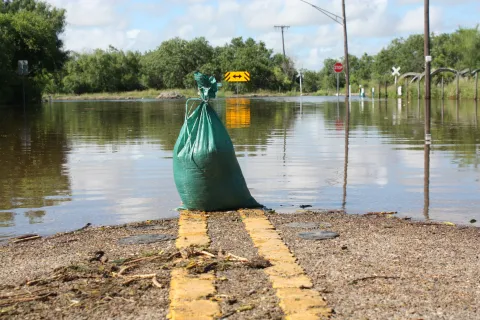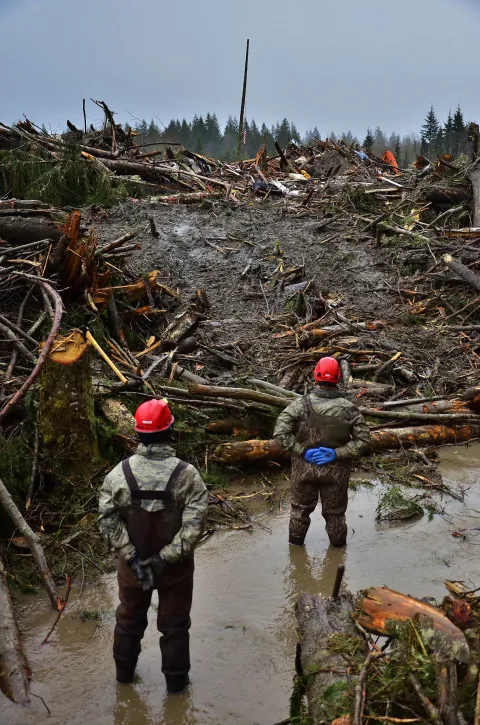December 18, 2025:
This section will be updated as the situation evolves
National Weather Service Watches, Warnings, and Advisories.
The National Weather Service has issued a Flood Warning for the Sandy River area. Multnomah County and the Cities of Troutdale and Gresham are monitoring the areas along the Sandy River and low-lying areas until further notice. Based on current weather forecasts, you may experience local flooding in your area. Monitor local weather updates and be aware of any fast-rising creeks or streams in your area.
Do not walk or drive on flooded roadways or through moving water. Also be aware of downed trees, limbs, and debris flows.
Report clogged drains, street flooding, or other hazards to your local public works or non-emergency dispatch line. Clear leaves and debris from gutters, storm drains, and downspouts to help water flow away from your home.
Review your household emergency plan and make sure essential items—such as medications, warm clothing, and flashlights—are easy to access.
Please do not call 9-1-1 unless there is an immediate threat to life or safety.
Helpful links:
City of Troutdale:
When heavy rain is in the forecast, remember that free sand and bags are available behind our Public Works Shop at 342 SW 4th St. Monday through Friday from 8:00 a.m. to 4:00 p.m. You'll need to bring your own shovel and fill, tie, load and transport the sandbags yourself. Please avoid any disruption of the City's crew operations. Please call 503-674-3300 for more information. Troutdale Sandbag Filling Station information.
To report an issue or submit non-emergency requests to the City of Troutdale, use their online Citizen Request Center.
City of Gresham:
Free sandbag station for Gresham residents located at 2123 SE Hogan Road.
Gresham residents needing sandbags to protect property from flooding or flows due to rain may access the City's free, fill-your-own sandbag station.
- Open 24 hours per day, November through March.
- Open to Gresham residents for home or private use only.
- The City provides bags and sand; you must bring your own shovel.
- Sandbags are not available for commercial or contractor use.
- Citizens are responsible for the sandbags after use; public works crews do not dispose or retrieve them.
- Sandbag station is open only during the rainy season.
Gresham Sandbag Filling Station information.
To report an issue or submit non-emergency requests to the City of Gresham, use their online My Gresham platform.
City of Wood Village
For anyone in Wood Village experiencing or concerned about flooding, the City has opened a free, self-service sandbag filling station located in the lower parking lot at Donald L. Robertson Park. Empty bags can be picked up inside City Hall until 4:30 PM both today and tomorrow.
Here a few important reminders:
Opt-in to emergency alerts at www.woodvillageor.govemergency-preparedness
Bring your own shovel as you will need to fill, tie, load, and transport the sandbags yourself
Bags cannot be picked up over the weekend, so prepare early by stopping by City Hall today or tomorrow before 4:30 PM
Call (503) 667-6211 with any questions or concerns
City of Portland
Flood safety and your property | Portland.gov
Need information or a connection for Gresham, Troutdale, Fairview, Wood Village, or another local government? Start with 311 and they'll connect you to the right people.
Do you want to receive emergency notifications? Sign up for Public Alerts!
Sign up to get emergency alerts when an emergency is happening near you or your loved ones. Log in and update your account if your address or contact information changes.
If you are in Multnomah County, you can sign up here. Signing up for these notifications allows emergency response agencies to notify you via text, voice call, or email when an emergency in your area may require you to take action (such as shelter-in-place or evacuation). You can register up to five addresses in the county for which you want to receive notifications, no matter where you are.
Just because you haven't experienced a flood in the past, doesn't mean you won't in the future. Flood risk isn't just based on history; it's also based on a number of factors: rainfall, river-flow and tidal-surge data, snow, topography, flood-control measures and changes due to building and development.
Flood Preparation
Educate yourself. Find out if you live in a flood zone by checking FEMA's local flood hazard maps or contacting your local Emergency Management agency.
Get insured. The National Flood Insurance Program (NFIP) offers flood insurance to homeowners, renters and business owners if their community participates in the NFIP. Learn more about coverage from the NFIP by visiting Floodsmart.org.
Safeguard your possessions. Conduct a household inventory to and keep copies of all of your critical documents. Knowing what you have and having it documented will make an insurance claim easier to handle should your home be affected by a flood.
Prepare your home and property. Here are some steps you can take to prepare your home and property in case of a flood:
- For information on emergency preparedness or emergency responses, please follow the County's main pages on Facebook, X or Bluesky.
- Sign up to get emergency alerts when an emergency is happening near you or your loved ones. Log in and update your account if your address or contact information changes. Signing up for these notifications allows emergency response agencies to notify you via text, voice call, or email when an emergency in your area may require you to take action (such as shelter-in-place or evacuation). You can register up to five addresses in the county for which you want to receive notifications, no matter where you are.
- Keep drains, culverts, gutters, streets and driveways clear of leaves and other debris to prevent localized flooding.
- Store flood lighting supplies like plastic sheeting, lumber and sandbags. Contact your local city or county to find out where you can get sandbags.
- Elevate the furnace, water heater and electrical panel above flooding level.
- If you have a basement, make sure your sump pump is working and has a battery-operated backup.
- If you have time, move furniture, valuables and important documents to a safe place.
Get a kit and make a plan.
- Plan and practice a flood evacuation route with your family. Know safe routes from home, work and school that are on higher ground.
- Ask an out-of-state relative or friend to be your emergency family contact.
- Put together a "Go-kit" for each family member and your animals. You may need to leave your home suddenly if a flood is imminent and a Go-kit will have all of the items you might need for at least 72 hours.
During a Flood

- Go to higher ground and avoid areas subject to flooding.
- Do not attempt to swim, walk, or drive, across flowing streams or flooded roadways. Turn around, don't drown!
- If trapped in a building, then go to its highest level. Do not climb into a closed attic. You may become trapped by rising floodwater. Go on the roof only if necessary. Once there, signal for help.
- Listen to a battery-operated radio for the latest storm information.
- Turn off all utilities at the main power switch and close the main gas valve if advised to do so.
- If you come in contact with floodwaters, wash your hands with soap and disinfected water.
After a Flood
- If your home has suffered flood damage, call your insurance agent to file a claim.
- Don't re-enter your home until flood waters have receded, you are cleared to return to your home and you have checked for structural damage.
- Take pictures and an inventory of any damage to your home or possessions.
- Keep power off until an electrician has inspected your system for safety.
- Boil water for drinking and food preparation until you are informed that your water supply is safe.
- Remove wet contents immediately to prevent mold.
- Wear gloves and boots while cleaning or disinfecting
More information about flooding, flood preparation and response can be found at Ready.gov and Floodsmart.gov.
Landslides, Rock Slides, Mud, and Debris Flows

Landslides occur in al US states and territories. In a landslide, masses of rock, earth, or debris move down a slope. They can be small or large, slow or rapid. Landslides are activated by storms, earthquakes, volcanic eruptions and the modification of land by humans.
Debris and mud flows are rivers of rock, earth and other debris saturated with water. They occur when water accumulates quickly in the ground, during rainfall and rapid snow melt, and change the earth into a flowing river of mud. They can flow very rapidly and often with little or now warning at high speeds.
Rock Slides are landslides involving bedrock in which the rock that moves remains largely intact for at least a portion of the movement. Rock Falls are landslides where a mass of rock detaches from a steep slope by sliding, spreading or toppling and descends mainly through the air by falling, bouncing or rolling
For materials you can print please view this document "Protect Your Home and Property: A Homeowner's Guide to Landslides for Washington and Oregon"
Landslide Preparation
Here are steps you can take to protect yourself from the effects of a landslide
or debris flow:
- Don't build near or on a steep slope, close to mountain edges, near drainage ways or natural erosion valleys.
- Get a ground assessment of your property.
- Consult a professional expert for advice on how to correct any issues on your property that may cause a landslide.
Recognize Landslide Warning Signs
- Changes in the landscape like storm-water drainage on slopes, land movement, small slides, flows or progressively leaning trees.
- New cracks appear in plaster, tile, brick or foundations.
- Outside walls, walks or stairs begin pulling away from the building.
- Developing and widening cracks appear in the ground or on paved areas.
- Water breaks through the ground in new locations.
- Fences, utility poles or trees tilt or move.
- The ground begins to shift in a downward slope.
During a Landslide
The following are guidelines for what you should do if a landslide or debris flow occurs:
- Move away from the path of a landslide or debris flow as quickly as possible.
- Curl into a tight ball and protect your head if escape is not possible.
After a Landslide
The following are guidelines for the period of time following a landslide:
- Stay away from the slide area and do not re-enter your home until cleared to do so by authorities.
- Check for injured and trapped persons near the slide and direct rescuers to their locations.
- Watch for broken electrical, water, gas and sewage lines and damaged roadways and railways.
- Seek advice from a geotechnical expert to reduce any remaining landslide hazards and risk.
